Zuo-Guang. Ye Advanced Dielectric Piezoelectric and Ferroelectric Materials: Synthesis, Characterisation and Applications
Подождите немного. Документ загружается.


600
20.1 Introduction
Functional materials in real applications have the form of patterned structures
rather than 2D infinite thin films. For example, piezoelectric micro-sensors
and micro-actuators involve piezoelectric thin films patterned into structures
of micrometer-range sizes. For future applications, e.g. memories, ferroelectric
films should be patterned into structures with lateral sizes in the nanometer
range. For example, in a prospective 10 Gbit non-volatile ferroelectric random
access memory (NV-FeRAM), the lateral area of the whole memory cell,
consisting of a capacitor and a transistor, should not exceed 100 nm, implying
ferroelectric capacitors having lateral sizes well below 100 nm [1, 2]. It is
well known that many materials change or even lose their useful properties
as soon as their sizes fall below a certain limit [3, 4]. During the past decade
a large amount of effort has been made to understand whether electroceramic
cells of 100 nm lateral sizes can still show piezo- or ferroelectric properties.
Most investigations were performed on ultra-thin films, but these can lead to
conclusions that are not always true for geometrically confined structures
such as islands, nanotubes or nanorods. In this case the relatively large
proportion of surfaces and interfaces can lead to domain pinning or to other
surface-related problems.
On the other hand the properties of nanostructures can also depend on the
route of their preparation. Different preparation methods can impose a certain
degree of specific defects, a certain porosity level, the incorporation of foreign
atoms or, for example, hydroxyl groups, interfacial stresses, etc. Additional
problems can occur during conventional and non-conventional patterning
processes when part of the continuous film is removed in order to obtain
separate structures [5–7]. Self-patterning methods seem to be appealing for
the production of good-quality structures that can be used for basic
investigations (e.g. for size–effect-related issues). Additional advantages of
such methods are usually lower fabrication costs (compared with, e.g.,
lithography-based routes) and relatively fast preparation time (compared
20
Nanosized ferroelectric crystals
I SZAFRANIAK-WIZA, Poznan University of
Technology, Poland and M ALEXE and D HESSE,
Max Planck Institute of Microstructure Physics, Germany
WPNL2204
Nanosized ferroelectric crystals 601
with, e.g., direct e-beam processes) [8]. That can make them attractive from
the point of view of potential applications. As one possible self-patterning
route, the formation of islands during very early stages of film formation has
been investigated [9–11].
In the middle of the 1990s, it was observed that the preparation of ultra-
thin epitaxial films by chemical solution deposition (CSD) is hindered by a
microstructural instability [12, 13]. Oxide thin films with a thickness below
a critical value break into islands after a high-temperature annealing. The
driving force of this process is an excess of the total free energy of the
continuous film compared with a film that only partially covers the substrate.
The free energy is minimized by (i) the film–substrate system through the
formation of surfaces of low energy [14], and eventually (ii) the formation of
islands, which lowers the interface area and thus the interface energy. Although
this effect has initially been regarded as an undesirable effect occurring
during the preparation of ultra-thin epitaxial films, it can favorably be applied
for the preparation of nano-islands. First attempts were focused on the
fabrication of lead titanate nanograins [15–17]. However, the choice of the
substrate, which was platinum-coated silicon, resulted in a random orientation
of the nanograins. The analysis of the size effect of such randomly oriented
nanograins can be rather complicated if there is no information on the crystal
orientation of each grain, because ferroelectric and piezoelectric properties
are closely connected with the crystallographic orientation [18]. A detailed
analysis of lead titanate and ferroelectric lead zirconate titanate nanostructures,
prepared on Pt-coated Si wafers, has shown that they do not possess single-
crystal quality, since twin boundaries were observed by transmission electron
microscopy (TEM) [9]. Therefore, it can be difficult to distinguish between
the intrinsic and extrinsic size effects associated with crystal imperfections.
The best way to investigate size effects in ferroelectrics is to produce single-
crystal, defect-free, monodomain nanostructures with controlled size and
orientation. The present chapter considers the preparation and properties of
single-crystal ferroelectric nanostructures obtained by the self-patterning
method based on the instability of ultra-thin films.
20.2 Preparation of nano-islands
Nanosize lead zirconate titanate epitaxial crystals were prepared by a
conventional chemical solution deposition. However, the film thickness was
much smaller compared with the conventional method, and the post-annealing
treatment was performed at slightly higher temperatures than usual [19]. The
amorphous ultra-thin films were deposited by spin-coating. Different single
crystals such as (001)-oriented SrTiO
3
(STO) (from CrysTec GmbH, Berlin),
(001)-oriented MgO and (001)-oriented LaAlO
3
(LAO) (both from Crystal
GmbH, Berlin) were used as substrates. For electrical measurements, STO
WPNL2204
Handbook of dielectric, piezoelectric and ferroelectric materials602
substrates with a niobium doping were used. The Nb concentration of 0.5%
ensures some conductivity, so that the substrate can also take the role of a
bottom electrode. Two types of solutions were used, viz. a commercial precursor
(PZT9906, Chemat Technology, Inc.) for Pb(Zr
0.52
Ti
0.48
)O
3
(denoted as PZT
52/48) and metalorganic solutions for lead zirconate titanate with different
Zr/Ti contents (denoted, e.g., PZT 20/80 for Pb(Zr
0.2
Ti
0.8
)O
3
). The initial
film thickness was determined by the degree of dilution of the raw precursors
in their solvents (butanol in the case of the commercial precursor, and xylene
for metalorganic ones) within a wide range (e.g. from 1:10 to 1:50 for
Pb(Zr
0.52
Ti
0.48
)O
3
), and by adjusting the spinning speed from 3000 to 6000 rpm.
The gel film obtained was dried on a hot plate at 80 °C for 5 min, pyrolized
at 300 °C for 5 min, and finally crystallized at 600–1100 °C for 5 min–10 h
in a lead-rich atmosphere. Energy dispersive spectroscopy (EDS) analysis in
a scanning electron microscope (SEM) was used to control the PZT
compositions. In all cases the composition after crystallization agreed well
with the nominal composition of the raw precursors.
20.2.1 The control of size and distribution of the nano-
islands
The growth of nanostructures was firstly investigated as a function of the
initial film thickness, the crystallization temperature, and the lattice mismatch
between the substrate and the nano-islands. The initial thickness of the deposited
amorphous layers has been adjusted by the combination of spinning speed
and dilution of the raw precursors. After crystallization at 800 °C for 1 h, the
final morphology of the layers was examined in SEM and by atomic force
microscopy (AFM). Figure 20.1 shows the SEM images of the final structures
of PZT 52/48 and lead titanate (PbTiO
3
, denoted as PT). The deposition
conditions were kept the same, only the precursor dilution was changed. All
AFM investigations have shown that the nano-islands obtained by this method
have similar height. As expected, thicker PZT 52/48 films, with an initial
thickness below the critical value, have transformed into films with faceted
holes after the crystallization. A deposition using a higher dilution results in
ultra-thin films, which, after the high-temperature crystallization, break up
into small single-crystal islands, as shown in Fig. 20.1. For the highest
dilution (1:40) the resulting islands have a height of about 9 nm and lateral
sizes of 40–90 nm with a relatively narrow distribution in size (Fig. 20.1d).
The islands are distributed on the substrate with a high density of about 150
crystals on an area of 1 µm
2
. Thicker layers obtained with lower dilution
(1:25) result in islands that are both larger and higher (Fig. 20.1b). Their
height increases to about 25 nm, and the distance between close neighbours
increases as well, resulting in a low areal density of the islands of about
30/µm
2
. If the initial film thickness is just below a critical value, larger
WPNL2204
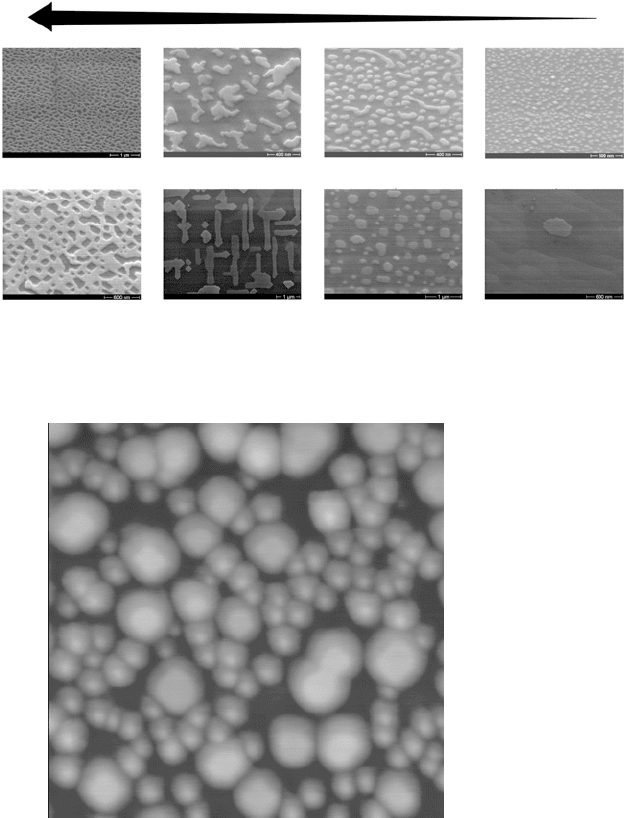
Nanosized ferroelectric crystals 603
islands of irregular shape form, as shown in Fig. 20.1a. The smallest structures
obtained in this way have a height of about 3–4 nm and a lateral size of 30–
40 nm according to the AFM investigation shown in Fig. 20.2.
Similar behavior has been observed for the PT structures. If the initial
film thickness is just above a critical value (dilution 1:5), faceted holes
develop in the film (Fig. 20.1e). The thinner initial layer (1:10) has broken
Initial layer thickness
PZT
PT
(a) (b) (c) (d)
(e) (f) (g) (h)
20.1
Scanning electron images of final PZT 52/48 (a)–(d) and PbTiO
3
(e)–(h) structures obtained after 1 h crystallization of ultra-thin films
at 800 °C.
20.2
AFM image of the smallest PZT 52/48 islands on STO (image
size 500 × 500 nm
2
, z range 10 nm).
WPNL2204

Handbook of dielectric, piezoelectric and ferroelectric materials604
up into relatively large islands. The islands have a different shape from the
PZT islands; they have formed elongated stripes, as shown in Fig. 20.1f. The
islands have an average height of 15 nm and a wide distribution in lateral
sizes, up to more than a few hundred micrometres. As it was observed
previously, thinner layers compared with thicker ones create more regular
islands that are both higher and laterally larger up to a height of about 20nm
(Fig. 20.1g) and their areal density is lower. The smallest islands obtained
from the 1:25 diluted precursor have a height of about 10 nm and lateral
sizes of about 50 nm with a relatively narrow distribution in size (Fig.
20.1h).
20.2.2 The influence of the crystallization temperature
The crystallization temperature plays an important role in the morphology of
the final structures. It was found that, in order to obtain uniform islands, a
thermal treatment at 800 °C for 1 h is necessary. The annealing at higher
temperature results in the formation of larger islands. For instance, as Fig.
20.3 shows, the height of nanocrystals obtained from the 1:40 diluted precursor
increases from 9 nm after a treatment at 800 °C up to 20 nm after an annealing
at 1100 °C. The area density drastically decreases down to 15–20 islands per
1 µm
2
. Most probably at higher temperature the mobility and surface diffusion
are enhanced and that allows the deposited material to migrate and to coalesce
into larger islands. As a result the PZT nano-islands are higher and more
separated.
The mechanism of nano-island formation can be described similarly to
that used to produce semiconductor quantum nanostructures in materials like
Ge on Si, in which the shape and distribution obeys the Shchukin–Williams
theory [20, 21]. This theory predicts the formation of three different kinds of
structure (pyramids, domes and superdomes) as a function of the coverage
(a) (b) (c)
20.3
AFM images (size: 2 × 2 µm
2
) of PZT 52/48 nanocrystals on
SrTiO
3
crystallized at (a) 800 °C (
z
range 20 nm), (b) 950 °C (
z
range
20 nm), and (c) 1100 °C (
z
range 35 nm).
WPNL2204
Nanosized ferroelectric crystals 605
and the crystallization temperature. The detailed analysis of the influence of
the thickness of the amorphous layer and the crystallization temperature on
the final shape of the PZT islands was presented in Dawber et al. [22]. For
large thicknesses superdomes are dominant; as the thickness is decreased the
coexistence of domes and superdomes changes to a dominance of domes.
The domes and superdomes can be distinguished both on the basis of size
(superdomes are significantly larger than domes) and the kind of facets
present (superdomes have steeper side facets and a larger flat top facet than
domes). After processing at higher temperatures (e.g. 1100 °C) even for the
thinnest amorphous layers the superdomes become dominant. This may be
advantageous for the fabrication of an array of superdomes which are further
spaced from each other, thus avoiding the formation of merged domes which
drastically reduce the degree of registration in an array of nanocrystals.
On the other hand a crystallization at higher temperatures can cause
undesirable effects. Quite often losses of volatile elements or compounds,
which become more important at higher temperature, have a big impact on
the final composition and the phase contents (e.g. pyrochlore phases are
formed instead of the perovskite phase). An additional disadvantage of this
treatment is the possibility of diffusion through layer/substrate interfaces,
which may result in the formation of solid solutions. Because of these facts
the lowest possible crystallization temperature (e.g. 800 °C) was chosen for
the fabrication of uniform nanostructures, the physical properties of which
have been investigated.
20.2.3 The effect of the lattice mismatch
As is clear from Fig. 20.1, the shape of the islands depends on the composition
of the deposited layer. The Zr/Ti ratio has an influence on the tetragonality
(i.e. the ratio c/a of the lattice parameters) and therefore the lattice mismatch
varies with the Zr/Ti composition (Fig. 20.4). The influence of the lattice
mismatch on the growth mechanism has been the subject of detailed studies
during recent decades [4]. The influence of the lattice mismatch on the
formation of nanoislands was investigated as well. For these investigations
several samples of different compositions were prepared, and all were
crystallized at 800° C for 1 h. The wide range of PZT compositions (Zr
contents between 0 and 48%) of islands deposited on single crystal STO,
LAO and MgO substrates provided a variation of the lattice mismatch δ (δ =
(a
island
– a
substrate
)/a
substrate
, where a are the respective lattice constants of
island or substrate) between 6.5% and 0.2%. It was shown that PT islands on
(001) STO substrates formed elongated structures (see Fig. 20.1), whereas
thin layers of PZT with higher Zr concentration broke up into smaller structures.
In the case of PZT/STO and PZT/LAO, small structures were obtained with
an average height of 10 nm and a lateral size of about 50 nm. The deposition
WPNL2204
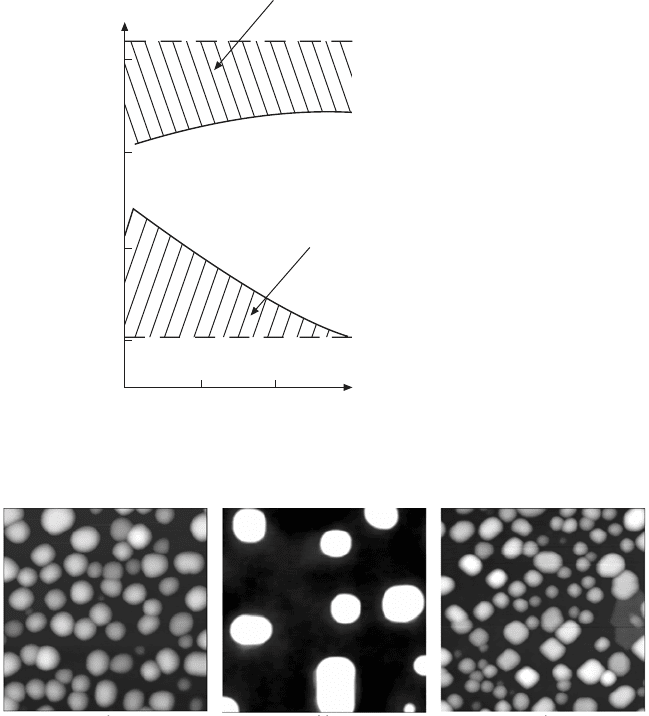
Handbook of dielectric, piezoelectric and ferroelectric materials606
of PZT onto LAO substrates produced two types of islands – smaller and
larger ones having a more square shape (Fig. 20.5). In both cases the islands
are distributed on the substrate with a high density of about 150–200 crystals
on an area of 1 µm
2
. PZT islands on MgO substrates became both laterally
larger and higher (Fig. 20.5). Their height increases to about 25 nm, and the
lateral size may reach a few hundred nanometers. Again due to the conservation
of the total volume, the distance between close neighbors increased resulting
in a low area density of the islands.
0.8 1.00.60.4
Ti/Zr
3.9
4.0
4.1
4.2
Unit cell parameter
a
- and
c
-orientation preferred
c
MgO
c
-orientation preferred
a
=
b
SrTiO
3
20.4
Schematic diagram of the lattice mismatch and possible
orientations of PZT.
(a) (b) (c)
20.5
AFM images of PZT 20/80 nanoislands with the same initial
thickness deposited on (a) (001) STO, (b) (001) MgO and (c) (001)
LAO. The images were taken from 500 × 500 nm
2
area,
z
range is
20 nm.
WPNL2204
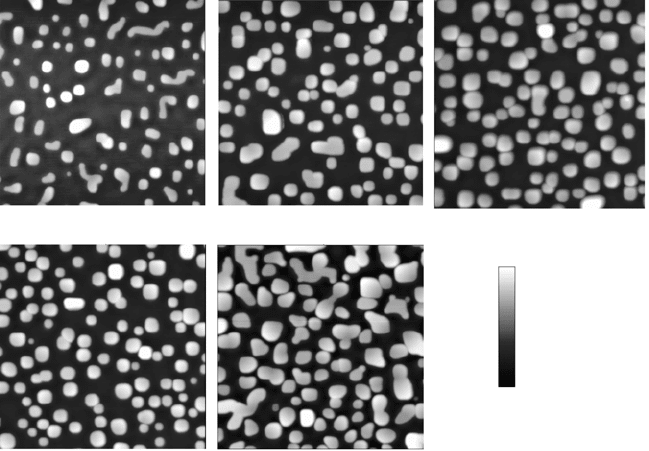
Nanosized ferroelectric crystals 607
The results clearly show that a certain value of the lattice mismatch strain
helps the total system to break up into islands. The smallest strain of PT/STO
(0.2%) allows elongated stripe-like structures to be prepared. The islands
obtained in such systems where the lattice mismatch is relatively large are
usually bigger, and their density on the surface is smaller; however, in this
case the islands usually possess two possible orientations (see Section 20.3.1
below).
20.2.4 Multi-step deposition
In order to control the sizes of the nano-islands more precisely, a multi-step
deposition procedure has been applied. Figure 20.6 shows the morphology
of PZT 20/80 structures on MgO after each deposition step, whereas Fig.
20.7 shows the deposition of PZT 52/48 on STO. The first deposited amorphous
layers with a thickness below the critical value were crystallized at 800 °C.
The films broke up to form nano-islands during the crystallization stage and
then samples were recoated with an amorphous layer having the same thickness
as the first layer. Again the film broke up during the thermal treatment. It
was observed that most of the ‘old’ islands increased their lateral size but
(a) (b) (c)
(d) (e)
40 nm
0 nm
20.6
PZT 20/80 nano-islands after (a) first, (b) second, (c) third, (d)
fourth and (e) fifth deposition on (001) MgO substrates. The scanning
area was 2 × 2µm
2
.
WPNL2204
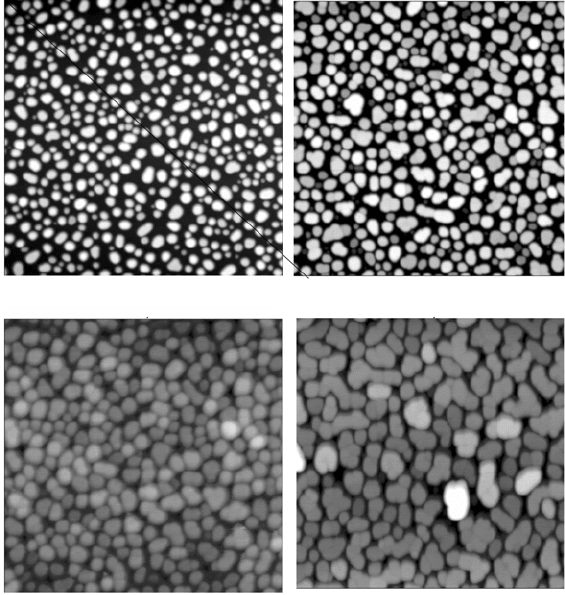
Handbook of dielectric, piezoelectric and ferroelectric materials608
new ones appeared with the same lateral size as those obtained previously. It
was possible to repeat this procedure several times until the islands started
to coalesce. Owing to the lower density of relatively big islands on the MgO
substrate it was possible to repeat the procedure up to five times, but in the
case of the very dense islands on STO the procedure was limited because
coalescence started already during the third step.
Generally this procedure can be repeated several times until a coalescence
process starts. From a practical point of view it is easier to use a multi-step
deposition procedure in the case of islands with a relatively large distance
between neighbors. A precise control of the island size could be possible
using a more diluted precursor; however, each deposition cycle (solution
deposition, pyrolysis, and crystallization step) could also increase the number
of dust particles and impurities on the sample surface. As a result such a thin
film would not be deposited homogeneously, resulting in large structures,
(a) (b)
(c) (d)
20.7
PZT 52/48 nano-islands after (a) first, (b) second, (c) third and (d)
fourth deposition on (001) STO substrates. The images were taken
from 2 × 2 µm
2
area,
z
-range 20 nm.
WPNL2204
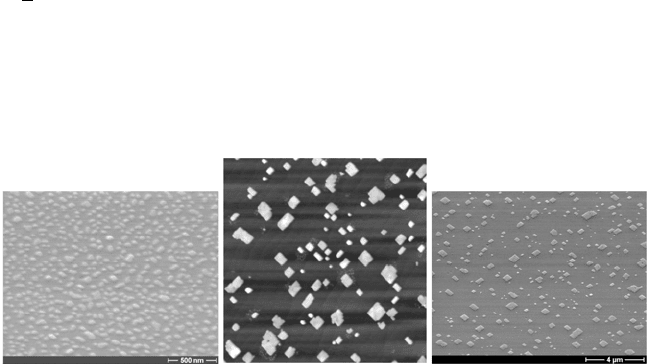
Nanosized ferroelectric crystals 609
often with a somewhat strange shape, or even in continuous films around
imperfections.
20.2.5 Towards nano-island registration
One of the disadvantages of self-assembly methods is the random distribution
of the final structures on the substrate. As expected, nanostructures obtained
by this method did not show an ordered arrangement in their positions. The
initial thin film broke up at random places, and formed a collection of irregularly
spaced nanocrystals. Because nanostructures are formed as the result of film
breaking, it is possible to introduce defects that could play an essential role
in creating discontinuities in the film during thermal treatment before the
crystallization process would start. Up to now the influence of two types of
defects has been investigated. In both cases the initial thin layer of PZT 52/
48 was deposited and dried at 80 °C. Then defect sites at regular spatial
intervals were intentionally introduced. During the first experiment defects
were created by mechanical imprint using a stamp with a regular array of
pyramidal SiN
4
structures. The height of the pyramids was about 260nm and
the spacing between them 0.5 µm. In the second experiment the defect sites
were imposed by an electron beam. In both cases the final structures obtained
after defect introduction and crystallization (Fig. 20.8) are apparently different
from the previous structures. The islands are larger and higher and they have
a well-defined rectangular shape. Their edges are parallel to the [110] and
[110]
crystallographic directions of the substrate. The distances between
nearest neighbors are much larger than in the case of non-treated samples. It
seems that the introduction of defects can be used as a method for registration;
however, the presented registration is still relatively poor. Most probably it
could be improved by optimizing the distance between the introduced detects
(a) (b) (c)
20.8
PZT 52/48 nanostructrures obtained after crystallization of the
same thick amorphous layer (a) not treated, (b) mechanically
imprinted (area 10 × 10 µm
2
,
z
range 50 nm), (c) periodically exposed
with 1000 µC/cm
2
doses and 1 µm pitch with the same initial
thickness.
WPNL2204
